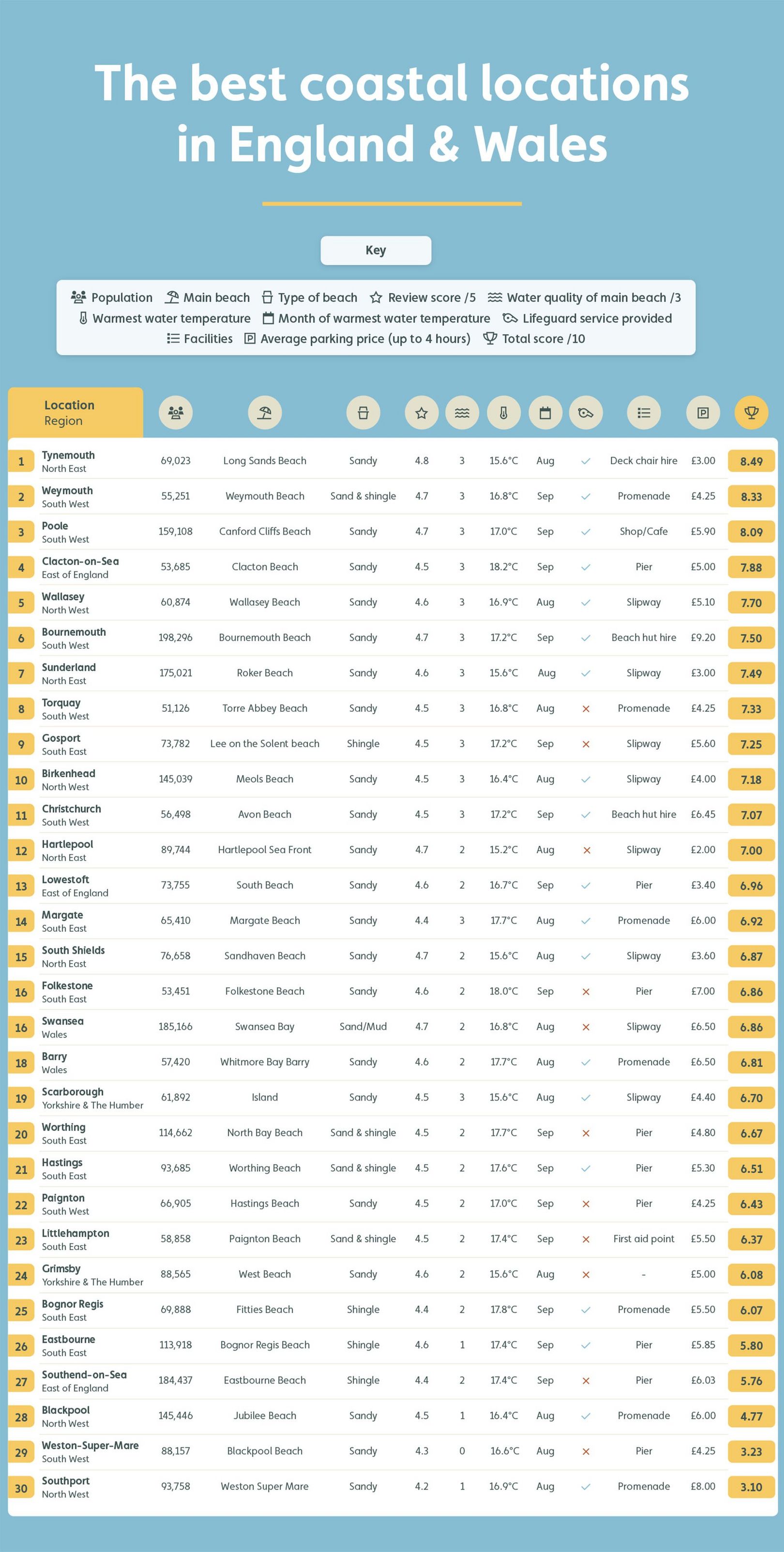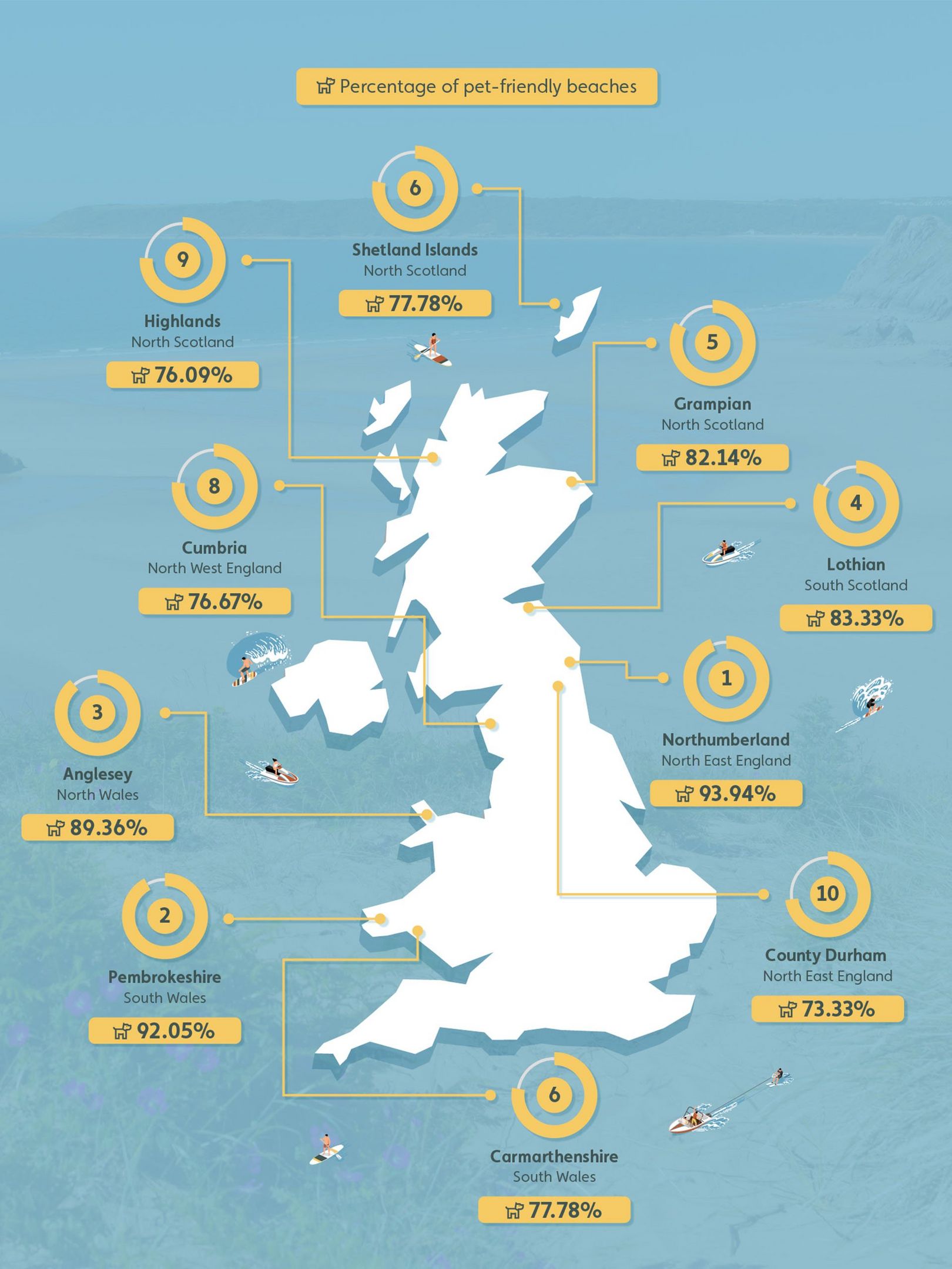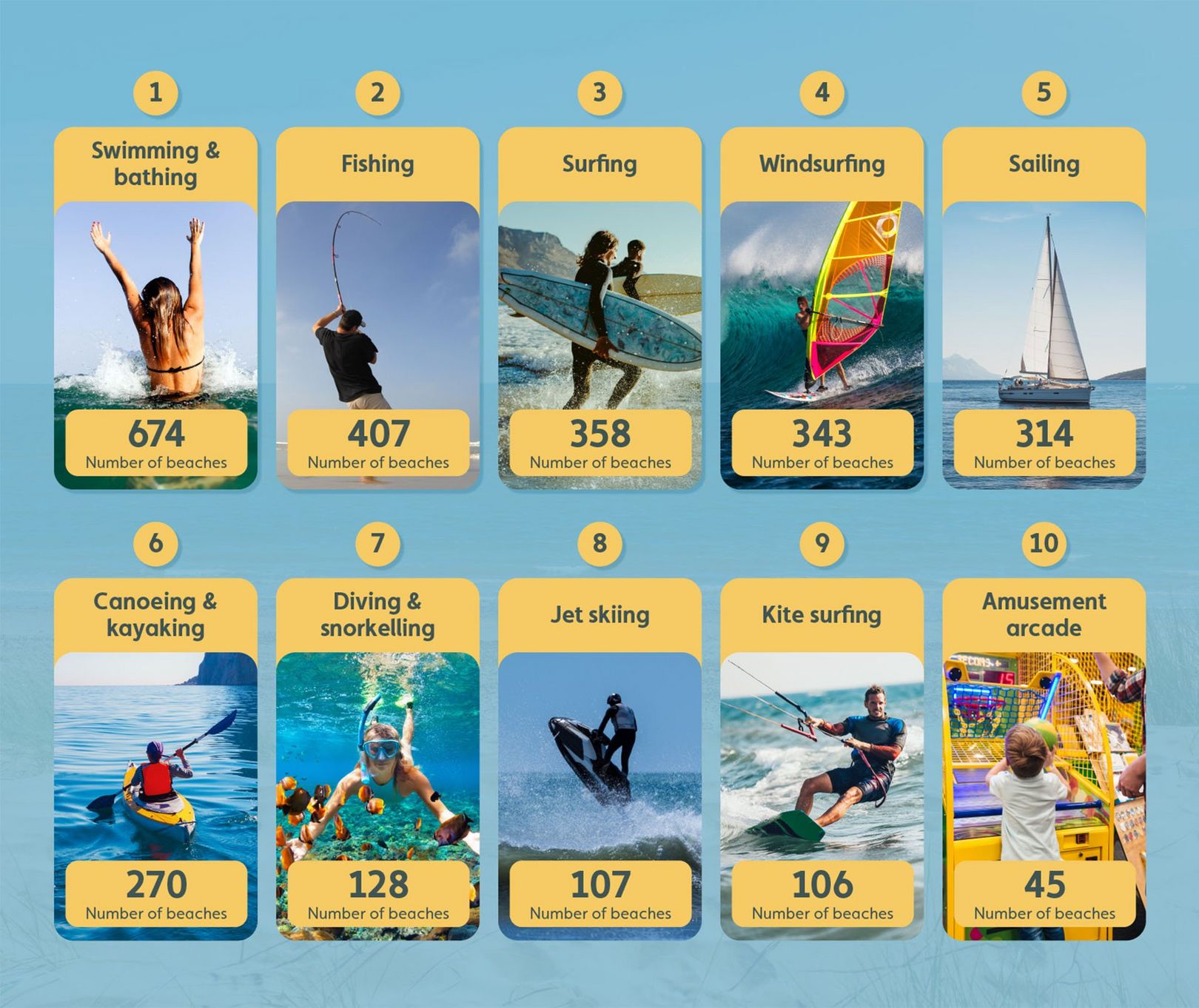The best coastal towns in England & Wales for you to explore this summer!
With summer fast approaching you may already be planning your holidays, and what would a summer holiday be without a beach? What could be better than packing your daysack and heading to the beach to experience the sound of waves, the gorgeous heat of the sun, and of course, ice cream?
Well, luckily, England and Wales are home to a whole range of beautiful and diverse beaches to choose from. From sandy havens, to the rustic aesthetics of shingle beaches, the choice can become almost overwhelming.
Research has revealed the best coastal beach holiday locations in England and Wales, looking at the most populated coastal areas. We looked at the average review ratings, the water quality ratings, the warmest ocean temperatures and also the average parking costs for up to 4 hours. Additionally, we reviewed the number of beaches for each region, which regions have the most pet-friendly beaches and the region with the most beach activities.
This allowed us to find the best coastal towns in England and Wales, to reveal where you should be heading this summer.
Jump to a Topic
The best coastal locations in England & Wales

To find the top coastal locations, we looked at a range of factors and then allocated each location a score out of 10 based on their performance in these areas. Specifically, we researched the Google review rating for the main beach of each coastal location, along with the water quality rating, warmest ocean water temperature and the average cost of parking for up to four hours.
1. Tynemouth, North East England
Main Beach: Long Sands Beach
Total Score: 8.49/10
The best coastal location in England and Wales is Tynemouth, located in the North East of England and scoring 8.49 out of 10 overall. The area’s main beach is Long Sands Beach, a beach well known for its long stretches of golden sand and the powerful waves in the area making it ideal for surfing.
Long Sands Beach has an overall rating of 4.8 out of 5 on Google Reviews, the highest of any beach we looked at. The Environment Agency gave this particular beach a rating of 3 out of 3, making it ideal water for people to swim in. However, the warmest temperature recorded for the water is just 15.6ºC. The average price of parking is around £3 for four hours, making it one of the cheapest of the beaches we looked at. And, in terms of facilities and accessibility at Long Sands, the beach offers deck chair hire, as well as designated disabled parking and ramps leading to the beach for wheelchairs.
2. Weymouth, South West England
Main Beach: Weymouth Beach
Total Score: 8.33/10
Next, we have Weymouth. Located in the South West of England is the aptly named and award-winning Weymouth Beach. This beach is located at the very heart of the Jurassic Coast, a World Heritage Site that stretches the southern coast of England.
Weymouth Beach has an overall Google Review score of 4.7 out of 5, from more than 5,000 reviews. The Environment Agency also gave this beach’s water quality rating of 3 out of 3, and the warmest water temperature recorded is 16.8ºC as of 2023. The average cost of parking however is £4.25, a bit more expensive than in Tynemouth. Weymouth Beach also has a promenade, making it easier to have a serene stroll along the beachfront. Additionally, they have beach wheelchairs for those who need them, as well as a ramp down to the beach for wheelchair users.
3. Poole, South West England
Main Beach: Canford Cliffs Beach
Total Score: 8.09/10
Poole is the third-best coastal area for you to explore this summer, scoring 8.09 out of 10 overall for the factors we looked at. The main beach is Canford Cliffs Beach, which has won a Blue Flag Award; it’s a gorgeous sandy beach and within walking distance of Canford Cliffs Village.
Canford Cliffs Beach also scored 4.7 out of 5 on Google Reviews, with a little over 1,100 reviews. Once again, the Environment Agency awarded this beach’s water with a maximum score on its water quality rating: 3 out of 3. The maximum water temperature for the area was recorded to be 17ºC, slightly higher than Weymouth. The average parking costs for up to 4 hours are around £5.90, higher than both previous beaches. Canford Cliffs facilities consist of various shops and cafes, providing easy access to refreshments on those scorching beach days. The beach is also accessible, providing easily accessible parking and easy access for wheelchair users.

Regions with the highest number of beaches

1. South West England
Number of Beaches: 452
The region in England and Wales with the highest number of beaches by far is the South West of England, with 452. The region is home to some significant UK landmarks, such as the South West Coast Path, the longest waymarked footpath in England and National Trail. Additionally, this region houses a portion of the Jurassic Coast, a World Heritage Site. Coastal erosion has revealed a range of rock formations from the Triassic, Jurassic and Cretaceous periods. The best beach in the South West is Weymouth Beach, characterised by its sand and shingle shores. The beach has a rating of 4.7 out of 5 on Google, no doubt thanks to its stunning blue waters and warm weather.
2. South East England
Number of Beaches: 199
Coming in second, we have another region of Southern England, with 199 beaches in total. The South East of England also has a portion of the Jurassic Coast, as the World Heritage Site stretches from Exmouth to Dorset. The region is home to multiple Blue Flag Award-winning beaches, such as Tankerton Beach and Margate Beach. The region also has two National Parks, South Downs and New Forest, the latter of which was once proclaimed a royal forest by William the Conqueror. The best beach in the South East is Lee-on-the-Solent beach, which lies between Portsmouth and Southampton. The beach is home to pebble shores and a peaceful atmosphere - perfect for families.
3. South Wales
Number of Beaches: 190
South Wales has the third-highest number of beaches, at a total of 190. The south of Wales is home to the UK’s only coastal National Park, the Pembrokeshire Coast National Park, which is 240 square miles. It is also the location of major cities such as Cardiff and Swansea, with rich maritime histories. The best beach in South Wales is Swansea Bay in Swansea. The beach is popular among visitors, with a rating of 4.7 out of 5 on Google.
Coastal destinations with the most pet-friendly beaches

1. Northumberland, North East England
Percentage Of Pet-Friendly Beaches: 93.94%
Northumberland, in the North East of England, has come out on top for the coastal destination with the most pet-friendly beaches. Of the 33 beaches in the area, 31 of them are pet-friendly, meaning that 93.94% are great options for pet owners. One pet-friendly beach is Beadnell Bay beach, a quiet and tranquil horseshoe shaped sandy beach on the Northumberland coast.
2. Pembrokeshire, South Wales
Percentage Of Pet-Friendly Beaches: 92.05%
We head to the South of Wales for the coastal location with the second-highest number of pet-friendly beaches. Manorbier Bay beach is pet friendly and has ideal shores for fishing, swimming, surfing, or dog walking. Pembrokeshire has a total of 88 beaches, 81 of which are rated to be pet-friendly or 92.05%.
3. Anglesey, North Wales
Percentage Of Pet-Friendly Beaches: 89.36%
Sticking with Wales, we go further north, where Anglesey has the third-highest number of pet-friendly beaches. This destination has 47 total beaches, 89.36% of which are pet-friendly, highlighting that Wales appears to be very accepting of pets on their beaches. Lleiniog Beach offers sand and shingle shores that are ideal for walking your pet, reading a book, or relaxing in the sun. You’ll also find plenty of dog-friendly walking routes in Wales.
Most common beach activities in England & Wales

1. Swimming/bathing
Number of Beaches: 674
This may not come as a surprise to the vast majority but swimming or bathing in the ocean is the most popular activity to do at beaches in England and Wales. Despite relatively cold temperatures, around 674 beaches in total listed this as their main beach activity, including beaches in Cornwall, Devon and Pembrokeshire.
2. Fishing
Number of Beaches: 407
The second-most popular activity for people to do at beaches in England and Wales is fishing. Around 407 beaches listed this activity as their main attraction for their beaches, including beaches in Pembrokeshire, Dorset and Anglesey.
3. Surfing
Number of Beaches: 358
The third-most popularly listed activity at beaches in England and Wales is surfing. Perhaps you don’t need to go to Australia for a surfing holiday, as 358 beaches listed this activity as their main attraction, including areas such as Cornwall, Gwynedd and Yorkshire.
We hope we’ve inspired you to head to the coast this summer. To find more inspiration, check out our Made For Adventure hub.
Methodology
For this campaign, we wanted to reveal the best coastal towns to explore this summer. To do this, we first collected a list of the top 30 most populated coastal towns in various regions across England and Wales using ONS data.
We then used information from the Beach Guide, looking at a variety of factors such as the number of beaches listed for each region on the site as this gave us a good indication of where in England and Wales has the most coastal scenes.
Looking at the main beach in each coastal town, we took the average review score for each town's main beach using Google reviews to reveal the top-rated beaches in the country.
Other factors were also taken into account, such as whether lifeguard service is provided, if it is pet-friendly, accessibility and any additional facilities. The Beach Guide was used for pet-friendly beaches and additional facilities, as well as whether a lifeguard service is provided. A variety of sources were used to research beach accessibility, such as council websites and specific websites for the coastal towns or specific beaches.
To find out just how safe the water is at these beaches, we analysed the places with the best and worst beach water quality, according to the Environment Agency, with ratings out of three (poor to excellent). For this section, we looked at the average sea temperature for each beach location listed.
Additionally, we wanted to highlight the types of activities available in each coastal town. Looking at the list of available sports and activities for each beach, we also analysed which beaches are best for certain seaside activities (e.g. canoeing or kayaking). This was done by reviewing how many specific activities each coastal location offers and then ranking them to find the best and worst beaches for activities.
To find out the cost of parking, we used a range of sources, such as council websites and specific websites for the coastal towns or specific beaches. We also ranked each location to find the beaches in England and Wales with the highest and lowest parking prices.





